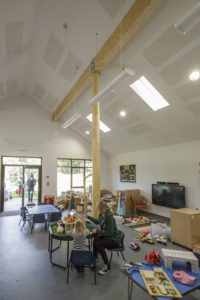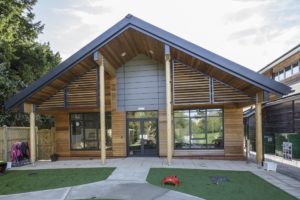A learning environment, or the physical, psychological and instructional atmosphere, can critically affect a pupil’s morale and learning, in the same way that a clean, bright, organised space can positively influence the learning experience.
Therefore, pupils should be encouraged to feel comfortable and confident as learners which is why the design of a classroom is so vitally important.

Scotts of Thrapston, specialists in the manufacture and installation of bespoke timber-framed buildings, has a dedicated design manager who studied classroom attainment and the effect of educational environments on children’s behaviour. Everything from light levels to atmosphere and the amount of CO2 present comes under the spotlight.
Richard Jarvis, Director for the buildings and joinery division at Scotts of Thrapston, said: “In our minds, the ideal learning environment begins with a building that inspires and motivates through its architectural form.
“Attention to the ceiling, wall and floor materials together with the furniture is crucial to conducive learning and all need design consideration – and our focus is not just on floorspace, but also volume, to keep the space properly ventilated.
“Our education buildings have been designed to be interesting, engaging and tactile. Each nursery or classroom building aims to meet the specific needs of those who will use it: pupils, teachers and parents.”
Lavenham Young Person’s Centre
When Scotts of Thrapston was appointed as the principal designer and main contractor to create a new Lavenham Young Person’s Centre, glulam was an obvious choice of material to meet the design brief.
The client, Lavenham Young Person’s Centre, working with Suffolk County Council, had specific design features for the 227sq m building, which primarily offers pre-school education for two to five-year olds.
These included high vaulted ceilings to prevent stale air becoming trapped. Sustainability and appearance were also important within the brief, with the client requesting a natural aesthetic, externally and internally, to help avoid a more clinical learning environment.

Scotts’ one-stop-shop approach meant it provided a complete ‘turnkey’ service from concept to completion. Working with its in-house architect, Scotts designed, engineered, manufactured and installed the building, with the handover taking place seven months after the order was placed, including a 21-week build programme.
Scotts offers cost-effective, high-quality, carbon efficient timber-framed buildings to suit a variety of end-user requirements. Different materials are chosen to create interest and emphasis is placed on providing a stimulating environment.
GL30 structural grade glulam beams and columns, with applied clear grade coating (to BS EN 927), were specified for this project. Structurally, glulam offers strength and durability due to its layered design which creates a material that can span long distances. It also provides a good strength to weight ratio when compared with steel and concrete.
The building is designed as a ‘hybrid’, using a traditional panelised timber frame with glulam supporting the main roof structure. The superstructure consists of a series of five metre high by 200mm diameter circular columns, which were designed to provide a safe play space for the children by avoiding harsh corners.
The glulam columns run from the exterior of the roof canopy right through the building, supporting the roof structure and 165cm x 405cm glulam beams which span the full 20m length of the building. Each glulam column is flitched at its top and base with 20mm diameter bolts to a steel flitch plate with a welded base bolted to the concrete foundation pad.
The frame was manufactured in-house at Scotts’ factory in Thrapston. It was then craned into the Lavenham grounds in kit form and assembled on site. All machining and plate connections were carried out in-house by Scotts’ joiners to millimetre accuracy prior to assembly.
Glulam was the perfect material to be used internally and externally. Secondary powder coated metalwork was included on the ends of the glulam beams to protect the end grain from excessive weathering.
In all projects undertaken that specify timber as a structural material, Scotts carefully embraces modern and traditional fire protection measures. This includes oversizing of members to last a calculated period of time in a fire, based on the rate at which it chars. Other measures include pressure applied Class 0 fire treatment and Magnesium Oxide board linings.
Lavenham Young Person’s Centre wanted an alternative facility to a traditional build. The durability, flexibility, strength and appearance of glulam helped Scotts fulfil that brief.
If you would like to read more articles like this then please click here.
The post Improving education through construction appeared first on UK Construction Online.
Walang komento:
Mag-post ng isang Komento